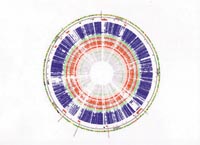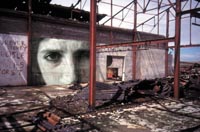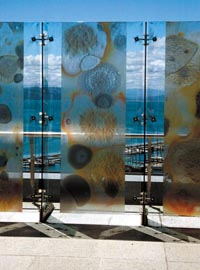
Discovering inspiration

Inspiration can be discovered in the strangest places. That much was clear at the first symposium this
month led by the University’s new Visiting Professor of Inspiration and Discovery David Mach. For him a
hair curler gave the design for a new motorway bridge. On another day it might have been a coat hanger, a
matchstick, a heap of autumn leaves or a pile of magazines that stimulated the self confessed "materials
junky" into creative mode. Others dealt in anatomy, the beauty of bodyparts, in fungi ("our closest
relatives in evolutionary terms"), in microscopic images of cells and subcellular structures, in potato
pathogens and penguins, in war and Cumbernauld, in Japan, in stunning computer game visuals and the Swiss
Army Knife.

At the end of a mind-bending day, cortically stretching to accommodate 10 presentations from artists,
medics and scientists, one thing was clear: where different disciplines collide you can expect explosions
of creativity.
David Mach creates his own explosions - sometimes, as in the case of his matchmaking sculptures, quite
literally. In a life-charged, funny, irreverent and inspirational presentation he romped the audience of
70 artists and scientists through a career which began with his student days at Duncan of Jordanstone
College when he created a real carpet of leaves - hand sown - surreally stretching skywards in Camperdown
Park, through his "magazines period", his "matches period", his "coathangers period", to his current
international cutting edge of contemporary art status: though he would never put it in those terms.
Exuberant diversions en route incorporated rusting cars, grand prix racers, brick trains and Battersea
chairs. Now as the UK’s first Professor of Inspiration and Discovery he will have unique access to a new
landscape of life science images, ideas and issues.

"I just think I'm incredibly lucky. This is exactly the kind of job you want as an artist," he said.
"Very often museums and galleries are the worst places in the world to work - they're dull, boring and
not stimulating at all. This is going to be very, very exciting."
For all of us. No-one knows where this project will lead. Already the first symposium took the audience
through some extraordinary landscapes - Chris Rowland and John McGhee's stunning 3D computer games
visuals applied to medicine; Graeme Houston taking the high end of technology and refocusing it on
communication with patients; Tim Frank honing the design of surgical instruments to a spare ergonomic and
aesthetic purity; Elaine Shemilt seamlessly shifting the application of her art from archives of
environmental data through the wastage of war to musical interpretations of the potato pathogen. Geoff
Gadd engaging all with his appreciation of fungi and bacteria "they make your food rot and your feet
smell"; Gair Dunlop with his archive footage of smiling futuristicscience as seen from the perspective of
the 50s, interlaced with Cumbernauld; Paul Harrison whose stunning images make words unnecessary;
Alan Prescott who opened a window onto a world invisible to the naked eye and, at a stroke created the
intriguing possibilities of bringing together Doom Games and stomata; and finally Tracy MacKenna and
Edwin Janssen tracing their artistic reactions to experiences in Japan. When science meets art, anything
can happen.
Over a series of visits in the coming year, David will meet with scientists and artists, catalysing the
process of inspiration and discovery. At the end of it all there are plans for an exhibition, for a
publication and for drawings and models of a public work of art inspired by the life sciences. What it
might be and where is anybody's guess at present but the adventure of inspiration and discovery has
barely begun.
Next Page
Return to November 2004 Contact

